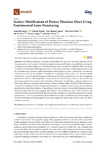Mostrar o rexistro simple do ítem
Surface Modification of Porous Titanium Discs Using Femtosecond Laser Structuring
| dc.contributor.author | Trueba Muñoz, Paloma | |
| dc.contributor.author | Amado, José | |
| dc.contributor.author | Rodríguez, Ángel | |
| dc.contributor.author | Tobar, M.J. | |
| dc.contributor.author | Giner, Mercé | |
| dc.contributor.author | Amigó, Vicente | |
| dc.contributor.author | Torres, Yadir | |
| dc.date.accessioned | 2020-06-23T16:08:53Z | |
| dc.date.available | 2020-06-23T16:08:53Z | |
| dc.date.issued | 2020-06 | |
| dc.identifier.citation | Rodríguez, Á.; Trueba, P.; Amado, J.M.; Tobar, M.J.; Giner, M.; Amigó, V.; Torres, Y. Surface Modification of Porous Titanium Discs Using Femtosecond Laser Structuring. Metals 2020, 10, 748. https://doi.org/10.3390/met10060748 | |
| dc.identifier.issn | 2075-4701 | |
| dc.identifier.uri | http://hdl.handle.net/2183/25779 | |
| dc.description.abstract | [Abstract] The failure of titanium implants is associated with two main problems that include the bone resorption and fracture of the surrounding bone tissue (stiffness incompatibility) and implant loosening (poor osseointegration). The development of porous titanium implants with low Young modulus solve the stress shielding phenomenon, while the modification of the implant surface must be implemented to promote a fast bond between the implant and bone. In this work, femtosecond laser micromachining was applied to modify the topography of the surface of Ti porous samples obtained by a space-holder technique to obtain hierarchical structures (micro and nano roughness patterns) to enhance osseointegration. Scanning electron microscopy, confocal laser microscopy, and image analysis were used for characterization of the surface morphology, roughness, and porosity before and after performing the laser treatment. Based on these results, the effect of the treatment on the mechanical behavior of the samples was estimated. In addition, a preliminary in-vitro test was performed to verify the adhesion of osteoblasts (filopodia presence) on modified titanium surface. Results revealed that laser texturing generated clusters of micro-holes and micro-columns both on the flat surface of the samples and inside the macro-pores, and periodic nanometric structures across the entire surface. The porous substrate offers suitable biomechanics (stiffness and yield strength) and bio-functional behavior (bone ingrowth and osseointegration), which improves the clinic success of titanium implants | es_ES |
| dc.description.sponsorship | Junta de Andalucía; US-1259771 | es_ES |
| dc.description.sponsorship | The regional government from Andalusia through FEDER-Junta de Andalucía Research Project US-1259771, (Modeling and implementation of the freeze casting technique: gradients of porosity with a tribomechanical equilibrium and electro-stimulated cellular behavior) funded this research. | |
| dc.language.iso | eng | es_ES |
| dc.publisher | MDPI | es_ES |
| dc.relation.uri | https://doi.org/10.3390/met10060748 | es_ES |
| dc.rights | Atribución 4.0 Internacional (CC BY 4.0) | es_ES |
| dc.rights.uri | https://creativecommons.org/licenses/by/4.0/ | * |
| dc.subject | Titanio poroso | es_ES |
| dc.subject | Huesos - Regeneración | es_ES |
| dc.subject | Rugosidad | es_ES |
| dc.subject | Láseres en cirugía | es_ES |
| dc.subject | Porous titanium | |
| dc.subject | Femtosecond | |
| dc.subject | Roughness patterns | |
| dc.subject | Surface modification | |
| dc.subject | Osseointegration | |
| dc.title | Surface Modification of Porous Titanium Discs Using Femtosecond Laser Structuring | es_ES |
| dc.type | info:eu-repo/semantics/article | es_ES |
| dc.rights.access | info:eu-repo/semantics/openAccess | es_ES |
| UDC.journalTitle | Metals | es_ES |
| UDC.volume | 10 | es_ES |
| UDC.issue | 6 | es_ES |
| UDC.startPage | 748 | es_ES |
| dc.identifier.doi | 10.3390/met10060748 |
Ficheiros no ítem
Este ítem aparece na(s) seguinte(s) colección(s)
-
CIT-LAIL - Artigos [31]






